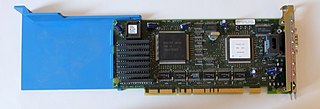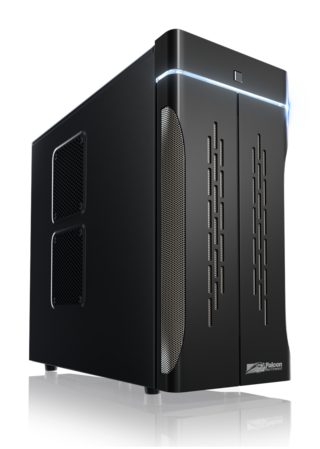
Micro Channel architecture, or the Micro Channel bus, is a proprietary 16- or 32-bit parallel computer bus introduced by IBM in 1987 which was used on PS/2 and other computers until the mid-1990s. Its name is commonly abbreviated as "MCA", although not by IBM. In IBM products, it superseded the ISA bus and was itself subsequently superseded by the PCI bus architecture.

The S-100 bus or Altair bus, IEEE 696-1983(withdrawn), is an early computer bus designed in 1974 as a part of the Altair 8800. The S-100 bus was the first industry standard expansion bus for the microcomputer industry. S-100 computers, consisting of processor and peripheral cards, were produced by a number of manufacturers. The S-100 bus formed the basis for homebrew computers whose builders implemented drivers for CP/M and MP/M. These S-100 microcomputers ran the gamut from hobbyist toy to small business workstation and were common in early home computers until the advent of the IBM PC.
Packard Bell Electronics, Inc., was an American computer company independently active from 1986 to 1996, now a Dutch-registered computer manufacturing brand and subsidiary of Acer Inc. The company was originally founded in 1986, after Israeli-American investors bought the trademark rights to the Packard Bell Corporation from Teledyne. The investors wanted to name their newly formed personal computer manufacturing company producing discount computers in the North American markets. In the late 1990s, Packard Bell became a subsidiary of Japanese electronics conglomerate NEC, Packard Bell NEC. In 1999, NEC stopped its North American operations and focused squarely the division on the European market, where it continued to sell PC and laptop under the Packard Bell name. In 2006, NEC divested Packard Bell, and in 2008, the brand was acquired by the Taiwanese consumer electronic firm Acer, in the aftermath of their takeover of Gateway, Inc.

AST Research, Inc., later doing business as AST Computer, was a personal computer manufacturer. It was founded in 1980 in Irvine, California by Albert Wong, Safi Qureshey, and Thomas Yuen, as an initialism of their first names. In the 1980s, AST designed add-on expansion cards, and evolved toward the 1990s into a major personal computer manufacturer. AST was acquired by Samsung Electronics in 1997 but was de facto closed in 1999 due to a series of losses.

In personal computing, a tower is a form factor of desktop computer case whose height is much greater than its width, thus having the appearance of an upstanding tower block, as opposed to a traditional "pizza box" computer case whose width is greater than its height and appears lying flat.

The Software Link, Inc. (TSL) was a company in Norcross, Georgia that developed software for personal computers from 1986 to 1994. The company was co-founded by Rod Roark and Gary Robertson.

The Deskpro 386 is a line of desktop computers in Compaq's Deskpro range of IBM PC compatibles. The computers feature Intel's 32-bit 80386 microprocessor. Introduced in September 1986, the Deskpro 386 is the first implementation of the 80386 processor in a computer system for sale to the public. It also marks the first time that a major component of the IBM Personal Computer de facto standard was updated by a company other than IBM themselves—in this case, upgrading from the 80286 processor of the Personal Computer/AT.

Reply Corporation, often shortened to Reply Corp., was an American computer company based in San Jose, California. Founded in 1988 by Steve Petracca, the company licensed the Micro Channel architecture from IBM for their own computers released in 1989, competing against IBM's PS/2 line. The company later divested from offering complete systems in favor of marketing motherboard upgrades for older PS/2s. Reply enjoyed a close relationship with IBM, owing to many of its founding employees, including Petracca, having worked for IBM. The company was acquired by Radius in 1997.

Advanced Logic Research, Inc. (ALR), was an American computer company founded in 1984 in Irvine, California by Gene Lu. The company marketed IBM PC compatibles across that standard's evolution until 1997, when it was acquired by Gateway 2000. ALR had a reputation for beating its larger competitors to market with compatibles featuring cutting-edge technologies but struggled with brand recognition among the fiercely competitive market of low-end PCs in the mid-1990s. According to computer journalist and collector Michael Nadeau, "ALR's business strategy was to be the first to market with the latest and fastest possible PC-compatible designs", a strategy that "often succeeded".

The Personal System/2 Model 30 and Personal System/2 Model 30 286 are IBM's entry-level desktop computers in their Personal System/2 (PS/2) family of personal computers. As opposed to higher-end entries in the PS/2 line which use Micro Channel bus architecture, the Model 30 features an Industry Standard Architecture bus, allowing it to use expansion cards from its direct predecessors, the PC/XT and the PC/AT. The original PS/2 Model 30 is built upon the Intel 8086 microprocessor clocked at 8 MHz; the Model 30 286 features the Intel 80286 clocked at 10 MHz.
Amdek Corporation was an American computer peripheral and system manufacturer active from 1981 to the mid-1990s. The company was renowned for their standalone computer monitors compatible with a wide array of systems from the early microcomputer era to the personal computer age. According to PC World in 1994, "Amdek was once the name in PC monitors. Chances are the monochrome monitors most of us used once carried the Amdek label." In the early 1980s, the company was majority owned by the Roland Corporation's Taiwanese subsidiary; in 1986, after a brief period of independence, the company was acquired by Wyse Technology, a maker of computer terminals, who continued the Amdek brand into at least 1995.

The Personal System/2 Model 25 and its later submodels the 25 286 and 25 SX are IBM's lowest-end entries in the Personal System/2 (PS/2) family of personal computers. Like its sibling the Model 30, the Model 25 features an Industry Standard Architecture bus, allowing it to use expansion cards from its direct predecessors, the PC/XT and the PC/AT—but not from higher entries in the PS/2 line, which use Micro Channel. Unlike all other entries in the PS/2 line, the Model 25 and its submodels are built into an all-in-one form factor, with its cathode-ray tube (CRT) monitor and system board occupying the same enclosure. IBM oriented the Model 25 at home office workers and students.
IBM EduQuest, later shortened to EduQuest, was a subsidiary of American multinational technology corporation IBM that catered to the elementary and secondary educational market. A spin-off of the company's Educational Systems division spearheaded by James Elton Dezell Jr. (1933–2000), EduQuest developed software and hardware for schools. Most prominent was their line of all-in-one personal computers, whose form factor was based on IBM's PS/2 Model 25.

Aox Inc. was a privately run American technology corporation founded by Michael and Linda Aronson in 1978. Over the course of its 22-year lifespan, the company chiefly developed software and hardware for IBM's PC and compatibles, for the Personal System/2, and for the Macintosh. In its twilight years, the company designed multimedia and teleconferencing devices and chip designs. Aox was founded after Michael Aronson graduated from Harvard University with a doctorate in physics; he stayed with the company until 2000, when he incorporated EndPoints Inc. and switched to full-time fabless semiconductor design.

Cumulus Corporation was an American computer peripheral and system manufacturer active from 1987 to 1993. Based in Beachwood, Ohio and started by Tecmar founder Martin Alpert, the company set out to exclusively manufacture expansion products for IBM's Personal System/2 (PS/2) family of computers—mainly RAM expansion cards. It later released cross-platform CPU upgrade cards and memory expansion cards for other platforms besides the PS/2. Beginning in 1990, the company began trading as Cumulus Computer Corporation and began releasing complete systems of their own. Initially a success story for the tech industry in Cleveland, a botched stock launch in 1992 proved disastrous for the company's ailing cash flow situation, and in 1993 the company was liquidated amid massive debt to suppliers and lenders.
Intelligent Systems Corporation (ISC) was an American technology company that sold portable computers, video terminals, expansion cards, and other peripherals through a variety of manufacturing subsidiaries. Founded in 1973, the company restructured as a master limited partnership in 1987, becoming Intelligent Systems Master Limited Partnership.
The MAD-1 is an IBM PC–compatible desktop computer released by Mad Computers, Inc., of Santa Clara, California, in 1984. The computer was noted among the technology press for its unique, modular design and its 80186 microprocessor, the latter seldom used in PC compatibles. It received positive reviews but sold poorly and was pulled from market a year later.
Pronto Computers, Inc., was an American computer company based in Torrance, California, active from 1983 to 1987. During its brief existence, the company released a duo of IBM PC compatible computer systems and a family of high-spec graphics cards. Pronto's first product, the System 16, was widely lauded for its graphical prowess and industrial design; in 1983, I.D. magazine named it the best-designed product in the field of instrumentation and equipment. The System 16 was followed up with the Pronto Transportable Solution, a portable computer. Both it and the Pronto 16 ran the Intel 80186, a microprocessor seldom used in IBM PC compatibles. Pronto Computers went bankrupt shortly after the Black Monday financial crisis of 1987.
CompuSource Compatible Systems Inc. was a short-lived privately held American computer company active in the 1980s and based in Minneapolis. It sold a variety of clones of the Apple II, including one portable that was also an IBM PC clone and a CP/M machine.












